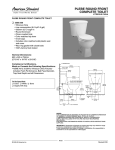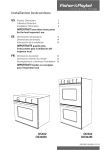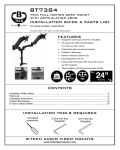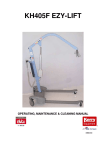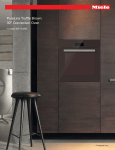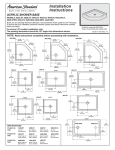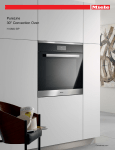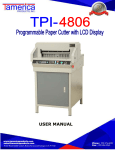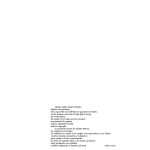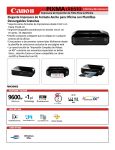Download Fisher & Paykel OD301 User's Manual
Transcript
New Zealand Australia PAGE 1 OF 8 P/N 545854C DATE OF ISSUE 11 / 2003 INSTALLATION INFORMATION TITAN BUILT - IN OVENS OS301 / OD301 SERIES I M P O R TA N T - S AV E F O R T H E O V E N I N S TA L L E R ’ S U S E BEFORE YOU START PAGE 2 OF 8 It is the customers responsibility to ensure that the product is electrically connected by a qualified electrical installer and conforms with all local electrical codes. Failure to install the product correctly could invalidate any warranty or liability claims and lead to prosecution. Make sure that the oven is located away from any strong and/or hot drafts of air. The cabinet opening dimensions specified are the absolute minimum. These dimensions allow a clearance of up to 6mm. The product must be electrically grounded. We recommend that the outlet for the electrical supply cable is located in the right rear corner of the cabinet cavity. This allows the electrical supply cable to sit inside the rear chamfered corner of the oven and prevents it being jammed between the cabinet wall and the rear of the oven. The oven support surface should be flat, level and be able to support a weight of at least (190 Kg) for a double oven and (108 Kg) for single oven models. You will need a No.2 Phillips screwdriver to complete the installation of the oven into the cabinet. There should be 4 suitable wood screws with this installation kit (Part number 556075) and 4 spacers (Part number 545455). Allow at least 1.5m free length of connection cable within the cavity for ease of installation and service of the oven. Ensure a suitable disconnection switch is incorporated in the permanent wiring, mounted and positioned to comply with the local wiring rules and regulations. Outlet for electrical supply New Zealand Australia PAGE 1 OF 8 P/N 545854C DATE OF ISSUE 11 / 2003 INSTALLATION INFORMATION TITAN BUILT - IN OVENS OS301 / OD301 SERIES I M P O R TA N T - S AV E F O R T H E O V E N I N S TA L L E R ’ S U S E BEFORE YOU START PAGE 2 OF 8 It is the customers responsibility to ensure that the product is electrically connected by a qualified electrical installer and conforms with all local electrical codes. Failure to install the product correctly could invalidate any warranty or liability claims and lead to prosecution. Make sure that the oven is located away from any strong and/or hot drafts of air. The cabinet opening dimensions specified are the absolute minimum. These dimensions allow a clearance of up to 6mm. The product must be electrically grounded. We recommend that the outlet for the electrical supply cable is located in the right rear corner of the cabinet cavity. This allows the electrical supply cable to sit inside the rear chamfered corner of the oven and prevents it being jammed between the cabinet wall and the rear of the oven. The oven support surface should be flat, level and be able to support a weight of at least (190 Kg) for a double oven and (108 Kg) for single oven models. You will need a No.2 Phillips screwdriver to complete the installation of the oven into the cabinet. There should be 4 suitable wood screws with this installation kit (Part number 556075) and 4 spacers (Part number 545455). Allow at least 1.5m free length of connection cable within the cavity for ease of installation and service of the oven. Ensure a suitable disconnection switch is incorporated in the permanent wiring, mounted and positioned to comply with the local wiring rules and regulations. Outlet for electrical supply PRODUCT DIMENSIONS PAGE 3 OF 8 718mm Oven Door 550mm Ove n Door 550mm 570mm 570mm 718mm OS301 OD301 757mm 1217mm 688mm 675mm 1230mm 757mm RECESSED DIMENSIONS PROUD DIMENSIONS PAGE 4 OF 8 TOP VIEW TOP VIEW 693mm - Single 1235mm - Double Recess Height 681mm - Single 1222mm - Double Inside Cabinet Height m t 5m de ne 57 Insi abi epth C D 724m Cabin m Inside et Wid th 681mm - Single 1222mm - Double Inside Cabinet Height Minimum Distance Under Benchtop for Single ovens 70mm Minimum Distance Under Benchtop for Single 70mm m t 5m de ne 59 Insi abi epth C D 20mm Reces s 724m Cabin m Inside et Wid th 762mm Reces s Width PRODUCT DIMENSIONS PAGE 3 OF 8 718mm Oven Door 550mm Ove n Door 550mm 570mm 570mm 718mm OS301 OD301 757mm 1217mm 688mm 675mm 1230mm 757mm RECESSED DIMENSIONS PROUD DIMENSIONS PAGE 4 OF 8 TOP VIEW TOP VIEW 693mm - Single 1235mm - Double Recess Height 681mm - Single 1222mm - Double Inside Cabinet Height m t 5m de ne 57 Insi abi epth C D 724m Cabin m Inside et Wid th 681mm - Single 1222mm - Double Inside Cabinet Height Minimum Distance Under Benchtop for Single ovens 70mm Minimum Distance Under Benchtop for Single 70mm m t 5m de ne 59 Insi abi epth C D 20mm Reces s 724m Cabin m Inside et Wid th 762mm Reces s Width PREPARING THE OVEN PAGE 5 OF 8 UNPACKING THE OVEN FLUSH FITTING INSTALLATION OPTIONS Do not use door handles or any part of the control panel for lifting the product. Before the product is lifted, the oven doors and racks are to be removed. a WARNING : Extreme care is to be taken when lifting the product as it is very heavy. Failure to do so may result in injury. 20 mm 1. Carefully lay the product on its back. Remove the external wrapping and the bottom polystyrene protector and pallet. Stand the product up and remove all other polystyrene packaging. 2. Remove the oven doors. This is done by: Open the oven door fully. Lift the catches on both of the hinges over towards you onto the hooks of the hinge arm (see picture below). Raise the door slightly, holding on either side near the handle, making sure that the clips stay on the hooks. 2.5 mm b 20 mm WARNING : Do not lift the door out by the handle as this may cause damage to the product. 2.5 mm Lift the door out. CUPBOARD FRONT Door Hinge Hook c Clip Door 20 mm WARNING : Do not disengage the hinge hooks when the door has been removed as they are differcult to re-engage. 2.5 mm DRAWER FRONT 3. Remove the wire shelves and oven trays by sliding them out. Use both hands to remove each item. Remove the cardboard packaging from the oven cavity. ELECTRICAL REQUIREMENTS PAGE 6 OF 8 The electrical voltage and frequency that is correct for this oven is stated on the serial number plate located inside the top vent. It is the customer responsibility to ensure that this oven is connected to the correct electrical supply. WARNING : The oven must be connected to a permanent and grounded supply. Maximum current draw and Maximum Load: Double : Single : 240V 38.2 A 9.2 kW 21 A 5.1 kW 220V 35 A 7.7 kW 19.5 A 4.3 kW WIRING REQUIREMENTS A circuit breaker appropriate for the product is recommended. WIRING INSTRUCTIONS 1. Remove the top panel from the product. 2. Feed the oven electrical supply cable through the grommeted hole on the 45o corner at the rear of the product. Then thread that cable through the burst hole and the wiring clamp. 3. Connect the electrical supply cable to the earth post and mains terminal block as indicated on the diagram below. It is recommended to use an appropriate terminal lug to connect the cable to the mains terminal block and earth post. 4. Secure the wiring clamp and re-fit the top panel. The electrical supply conduit must be securely clamped in the cable clamp located inside the product. Do ensure a suitable disconnection switch is incorporated in the permanent wiring, positioned to comply with the local wiring rules and regulations. A means of disconnection with at least a 3mm air gap contact separation in all poles must be incorporated into the fixed wiring in accordance with the wiring rules, unless the local wiring rules allow for the following variation. A means of disconnection from the supply having an air gap separation in all active (phase) conductors must be incorporated in to the fixed wiring. wiring clamp PREPARING THE OVEN PAGE 5 OF 8 UNPACKING THE OVEN FLUSH FITTING INSTALLATION OPTIONS Do not use door handles or any part of the control panel for lifting the product. Before the product is lifted, the oven doors and racks are to be removed. a WARNING : Extreme care is to be taken when lifting the product as it is very heavy. Failure to do so may result in injury. 20 mm 1. Carefully lay the product on its back. Remove the external wrapping and the bottom polystyrene protector and pallet. Stand the product up and remove all other polystyrene packaging. 2. Remove the oven doors. This is done by: Open the oven door fully. Lift the catches on both of the hinges over towards you onto the hooks of the hinge arm (see picture below). Raise the door slightly, holding on either side near the handle, making sure that the clips stay on the hooks. 2.5 mm b 20 mm WARNING : Do not lift the door out by the handle as this may cause damage to the product. 2.5 mm Lift the door out. CUPBOARD FRONT Door Hinge Hook c Clip Door 20 mm WARNING : Do not disengage the hinge hooks when the door has been removed as they are differcult to re-engage. 2.5 mm DRAWER FRONT 3. Remove the wire shelves and oven trays by sliding them out. Use both hands to remove each item. Remove the cardboard packaging from the oven cavity. ELECTRICAL REQUIREMENTS PAGE 6 OF 8 The electrical voltage and frequency that is correct for this oven is stated on the serial number plate located inside the top vent. It is the customer responsibility to ensure that this oven is connected to the correct electrical supply. WARNING : The oven must be connected to a permanent and grounded supply. Maximum current draw and Maximum Load: Double : Single : 240V 38.2 A 9.2 kW 21 A 5.1 kW 220V 35 A 7.7 kW 19.5 A 4.3 kW WIRING REQUIREMENTS A circuit breaker appropriate for the product is recommended. WIRING INSTRUCTIONS 1. Remove the top panel from the product. 2. Feed the oven electrical supply cable through the grommeted hole on the 45o corner at the rear of the product. Then thread that cable through the burst hole and the wiring clamp. 3. Connect the electrical supply cable to the earth post and mains terminal block as indicated on the diagram below. It is recommended to use an appropriate terminal lug to connect the cable to the mains terminal block and earth post. 4. Secure the wiring clamp and re-fit the top panel. The electrical supply conduit must be securely clamped in the cable clamp located inside the product. Do ensure a suitable disconnection switch is incorporated in the permanent wiring, positioned to comply with the local wiring rules and regulations. A means of disconnection with at least a 3mm air gap contact separation in all poles must be incorporated into the fixed wiring in accordance with the wiring rules, unless the local wiring rules allow for the following variation. A means of disconnection from the supply having an air gap separation in all active (phase) conductors must be incorporated in to the fixed wiring. wiring clamp ATTACHMENT PAGE 7 OF 8 WARNING : Extreme care is to be taken when lifting the product as it is very heavy. Failure to do so may result in injury. 1. Slide the product into the oven cabinet, pushing the product between the two oven cavities or by the edges of the oven cavity. If the product does not sit flush with the front of the oven cabinet, make certain that the electrical supply cable has not jammed behind the product. Ensure the bottom vent is not blocked off or damaged. screw screw screw 2. Securely fasten the oven to the cabinet using the screws provided. Insert the screws through the holes in the side extrusions and through the spacers placed between the side extrusion and the kitchen joinery (see diagram opposite). Do not over tighten screws. 3. Replace the oven trays and wire shelves. The shelves have a front and back. Insert them into the oven in the correct way to ensure that the ‘stop-lock’ feature of the shelf works correctly (see diagram opposite). 4. Refit the oven doors. This is done by: Place both upper hinge arms in the top slots and both lower hinge arms in the lower slots. Push the hinges as far as they will go until the slot in the lower arm locates in the hinge support. Lower the door gently. Push the catches away from you off the hooks. Make sure that they disengage properly. Raise the door slightly and ensure the catches are released from the hooks. The door can now be closed. WARNING : Do not stand or sit on the doors. CHECKLIST TROUBLE SHOOTING PAGE 8 OF 8 1. Make sure product is level and securely fitted to the cabinetry and both oven doors open and close freely. 2. Make sure all the internal packaging has been removed from the oven cavity. 3. Make sure all oven vents and openings are clear and are free of any obstruction. WARNING : Failure to do so may result in a fire or poor product performance. IF THE OVEN DOES NOT OPERATE: Check that the circuit breaker has not tripped or the fuse blown. Ensure that the electrical connections have been correctly made. Ensure that power is being supplied to the oven. Ensure the voltage is correct across all phases. Ensure the clock has been set. IF YOU NEED ASSISTANCE: If a fault occurs consult the Problem Solver Section of your User Guide book. Call your local Customer Care representative: 4. Turn the power to the oven on. The clock should light up and blink 12:00pm. 5. Set the clock to the current time. 6. Turn the oven function switch to ‘Bake’ and the oven temp switch to 200oC. Air should blow out of the vent at the bottom of the oven. Inside the oven cavity all three oven lights should come on. After 5 minutes open the oven door and the air inside should feel warm. The top element should be glowing red and the bottom surface of the oven cavity should feel warm to lightly touch. WARNING : Do not touch the top element as this may result in injury. 7. Turn both the oven function switch and oven temp switch back to off and repeat for the other oven if product is a double. FOR NEW ZEALAND P.O. Box 58732, Greenmount, Auckland. Toll Free 0800 FP CARE (0800 37 2273) Fax 09 273 0656 Email [email protected] FOR AUSTRALIA P.O. Box 798, Cleveland, QLD 4163. Toll Free 1300 650 590 Tel 07 3826 9100 Fax 07 3826 9298 Email [email protected] Please have the model and serial number of your product ready for the Customer Care representative. ATTACHMENT PAGE 7 OF 8 WARNING : Extreme care is to be taken when lifting the product as it is very heavy. Failure to do so may result in injury. 1. Slide the product into the oven cabinet, pushing the product between the two oven cavities or by the edges of the oven cavity. If the product does not sit flush with the front of the oven cabinet, make certain that the electrical supply cable has not jammed behind the product. Ensure the bottom vent is not blocked off or damaged. screw screw screw 2. Securely fasten the oven to the cabinet using the screws provided. Insert the screws through the holes in the side extrusions and through the spacers placed between the side extrusion and the kitchen joinery (see diagram opposite). Do not over tighten screws. 3. Replace the oven trays and wire shelves. The shelves have a front and back. Insert them into the oven in the correct way to ensure that the ‘stop-lock’ feature of the shelf works correctly (see diagram opposite). 4. Refit the oven doors. This is done by: Place both upper hinge arms in the top slots and both lower hinge arms in the lower slots. Push the hinges as far as they will go until the slot in the lower arm locates in the hinge support. Lower the door gently. Push the catches away from you off the hooks. Make sure that they disengage properly. Raise the door slightly and ensure the catches are released from the hooks. The door can now be closed. WARNING : Do not stand or sit on the doors. CHECKLIST TROUBLE SHOOTING PAGE 8 OF 8 1. Make sure product is level and securely fitted to the cabinetry and both oven doors open and close freely. 2. Make sure all the internal packaging has been removed from the oven cavity. 3. Make sure all oven vents and openings are clear and are free of any obstruction. WARNING : Failure to do so may result in a fire or poor product performance. IF THE OVEN DOES NOT OPERATE: Check that the circuit breaker has not tripped or the fuse blown. Ensure that the electrical connections have been correctly made. Ensure that power is being supplied to the oven. Ensure the voltage is correct across all phases. Ensure the clock has been set. IF YOU NEED ASSISTANCE: If a fault occurs consult the Problem Solver Section of your User Guide book. Call your local Customer Care representative: 4. Turn the power to the oven on. The clock should light up and blink 12:00pm. 5. Set the clock to the current time. 6. Turn the oven function switch to ‘Bake’ and the oven temp switch to 200oC. Air should blow out of the vent at the bottom of the oven. Inside the oven cavity all three oven lights should come on. After 5 minutes open the oven door and the air inside should feel warm. The top element should be glowing red and the bottom surface of the oven cavity should feel warm to lightly touch. WARNING : Do not touch the top element as this may result in injury. 7. Turn both the oven function switch and oven temp switch back to off and repeat for the other oven if product is a double. FOR NEW ZEALAND P.O. Box 58732, Greenmount, Auckland. Toll Free 0800 FP CARE (0800 37 2273) Fax 09 273 0656 Email [email protected] FOR AUSTRALIA P.O. Box 798, Cleveland, QLD 4163. Toll Free 1300 650 590 Tel 07 3826 9100 Fax 07 3826 9298 Email [email protected] Please have the model and serial number of your product ready for the Customer Care representative.








